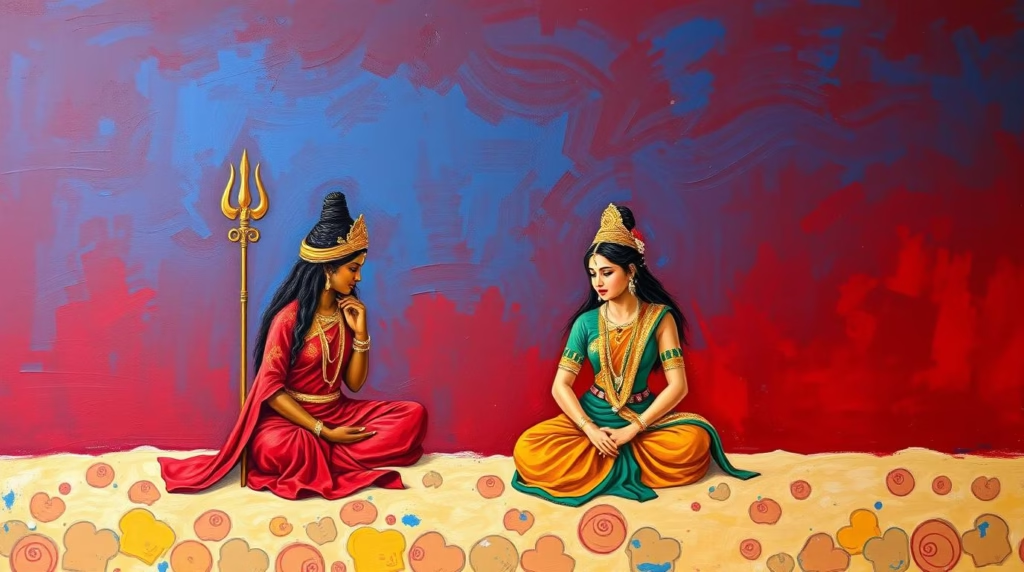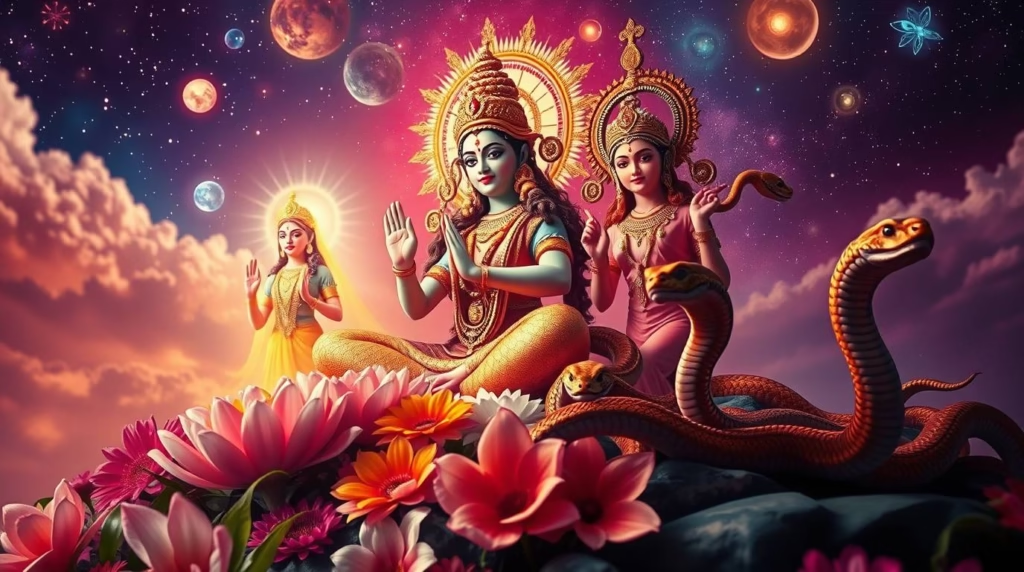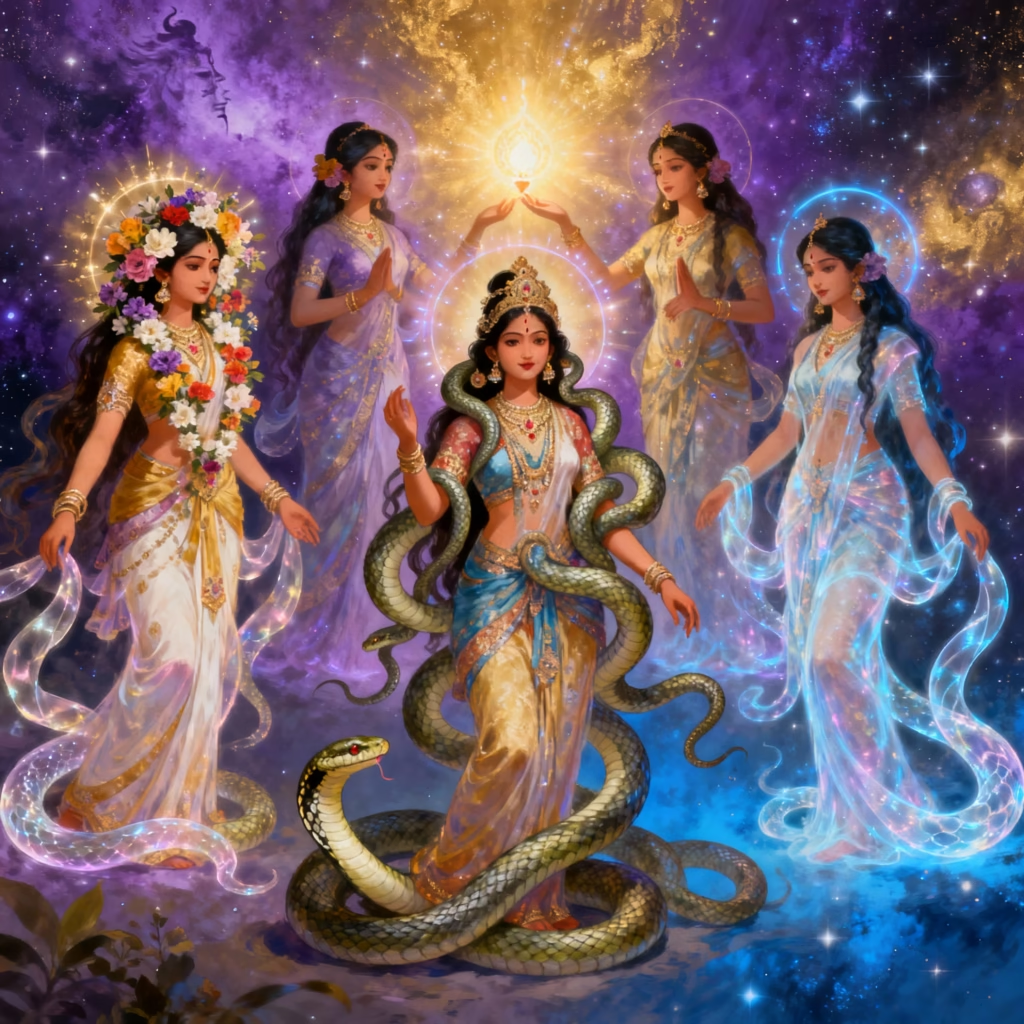The Mysterious Daughters of Shiva: Divine Feminine Energy Beyond Ganesha and Kartikeya
When most people think of Lord Shiva’s family, the familiar names of Ganesha, Kartikeya, and Goddess Parvati immediately come to mind. These figures are well-known in Hindu mythology, appearing prominently in stories, festivals, and devotional practices. But few know about another fascinating aspect of Lord Shiva’s divine household — his mystical daughters.
Hidden within the Shiva Purana, Padma Purana, and various regional scriptures, these extraordinary daughters are powerful manifestations of Shiva and Parvati’s combined energy (Shakti and Shiva Tattva). Each represents a distinct aspect of feminine divinity — wisdom, beauty, healing, illumination, and mystery.
While mainstream mythological retellings rarely focus on them, learning about these divine daughters offers a richer, more nuanced understanding of Hindu cosmology. They embody the perfect equilibrium of masculine and feminine energies — the dynamic creative power that complements Shiva’s ascetic stillness.
In this article, we explore the stories, spiritual symbolism, and significance of these divine daughters, shining light on the lesser-known side of the great Mahadeva’s legacy.
Ashoka Sundari — The Maiden Who Dispels Sorrow
Name Meaning: “One who removes sorrow and is beautiful”
Ashoka Sundari’s origin is an enchanting story of love, loneliness, and divine grace. According to the Padma Purana, while Lord Shiva was in deep meditation for extended periods, Goddess Parvati sometimes felt lonely in her abode, Mount Kailash. Seeking companionship, she performed intense prayers beneath the Kalpavriksha, the wish-fulfilling celestial tree.
Responding to her heartfelt wish, the Kalpavriksha granted her a beautiful daughter. Thus, Ashoka Sundari was born — radiant, compassionate, and divine in every way.
Ashoka Sundari’s Destiny
Ashoka Sundari’s life was intertwined with her destined consort, Nahusha, a noble prince who would one day ascend to great power. However, their union faced trials. A demon named Hunda tried to abduct her and prevent the marriage. Ashoka Sundari, displaying courage and intelligence, overcame adversity and stood firm in her devotion.
Her story is one of patience, resilience, and inner strength, transforming moments of solitude into opportunities for spiritual growth. In certain South Indian traditions, she is worshipped as Bala Tripurasundari, a youthful form of the divine mother representing innocence, purity, and potential.
Symbolism: Ashoka Sundari represents hope, the strength that arises from emotional endurance, and the spiritual truth that loneliness can be a path to empowerment.
Jyoti — The Guiding Light of Consciousness
Name Meaning: “Light” or “Radiance”
Jyoti is a more obscure daughter of Shiva mentioned in select recensions of the Shiva Purana. Her tale is not as elaborately chronicled as that of Ashoka Sundari, yet her presence carries immense spiritual significance. She is a living metaphor for divine illumination.
The Spiritual Meaning of Jyoti
In Hindu philosophy, light symbolizes knowledge, clarity, and liberation from ignorance. Jyoti reflects her father’s cosmic role as the destroyer of darkness, both literal and metaphorical. She embodies the Atma Jyoti — the inner flame of consciousness that guides every being toward enlightenment.
Though rarely worshipped in temples, Jyoti’s concept is invoked by yogis, saints, and seekers who meditate upon the inner light during spiritual practice. She signifies the soul’s eternal brilliance unaffected by the illusions of the material world.
Symbolism: Jyoti is the reminder that each soul carries an inner spark of divinity — the guiding light that connects us back to the Supreme.
Manasa — Goddess of Serpents, Fertility, and Healing
Among Shiva’s mystical daughters, Manasa Devi is the most widely worshipped, especially in Bengal, Assam, and parts of eastern India. She holds a prominent place in folk traditions and Tantric practices as the goddess of snakes, fertility, and healing.
Origins of Manasa
Her origin stories vary — in some traditions, she is born from Shiva’s mind (Manasa meaning “born of the mind”); in others, she appears through his union with a celestial being. Despite her divine nature, Manasa faced challenges. Parvati did not fully accept her, and her own father, Shiva, kept a certain distance. This struggle for recognition forms a major part of her narrative.
Worship and Cultural Relevance
Manasa protects people from snakebites — a crucial role in ancient agrarian societies where venomous snakes were a constant danger. She is also associated with fertility, ensuring the wellbeing of crops and family prosperity.
Her most symbolic role lies in her connection to the Kundalini Shakti — often depicted as a coiled serpent resting at the base of the spine. Awakening this energy leads to spiritual illumination and self-realization, mirroring Manasa’s position as a bridge between earthly needs and spiritual awakening.
Symbolism: Manasa embodies wisdom, protection, healing, and the awakening of hidden spiritual potential.
The Five Formless Daughters — The Nagakanyas
One of the most mysterious legends in the Shiva Purana and regional Tantric traditions speaks of five formless daughters of Shiva, known as Nagakanyas (serpent maidens).
According to the lore, during a divine moment of play and union between Shiva and Parvati, a drop of Shiva’s semen fell upon a lotus leaf. From this cosmic seed emerged five ethereal serpent maidens. These daughters were not human but fluid, formless manifestations of pure energy.
Shiva cherished them, but Parvati remained unaware of their existence, adding an air of secrecy to their relationship with their father.
Mystical Interpretations
Each Nagakanya represented a primordial aspect of nature’s vitality and transformation — elusive, ever-flowing, and eternal. Just as serpents shed their skin, the Nagakanyas symbolized rebirth, hidden energy, and transcendence.
Some scholars view them as allegorical figures for latent cosmic energies — invisible yet ever-active forces that maintain the balance of creation, much like the uncoiling serpent of Kundalini Shakti during spiritual awakening.
Symbolism: The Nagakanyas represent transformation, mystery, the cycles of nature, and the unseen powers that shape the universe.
Symbolism and Deeper Meaning of Shiva’s Daughters
The daughters of Shiva are not mere supporting characters in Hindu lore — they are archetypes of feminine divinity that balance the still, meditative essence of Shiva with active aspects of creation, emotion, and preservation.
-
Ashoka Sundari — Joy, hope, emotional strength
-
Jyoti — Inner illumination and enlightenment
-
Manasa — Healing, protection, Kundalini awakening
-
Nagakanyas — Transformation, mystery, formless divine energy
Collectively, they reaffirm the concept that Shakti — the divine feminine principle — manifests in infinite ways to sustain the cosmos. The creative dance of masculine and feminine forces is an eternal truth encoded in Hindu spiritual philosophy.
The Forgotten Feminine Forces in Shiva’s Legacy
In popular culture and devotional practice, much focus is placed on Shiva’s image as the supreme ascetic, destroyer of ignorance, and father to Ganesha and Kartikeya. However, the stories of his daughters reveal another truth — Lord Shiva is also a custodian of feminine creativity and nurturing power.
His daughters’ lives bridge the visible and the invisible, the earthly and the cosmic. Where Shiva represents the transcendental stillness, they bring flow, movement, healing, and vitality.
Rediscovering these feminine forces allows modern devotees and seekers to appreciate the wholeness of divine energy. Masculine without feminine is incomplete; the universe thrives on their harmonious balance.
Spiritual Relevance in Modern Times
The narratives of Shiva’s daughters hold timeless lessons relevant even in today’s world:
-
Balancing Opposites: Like the yin and yang, masculine and feminine energies must coexist in harmony for wholeness.
-
Self-Illumination: Jyoti teaches that the ultimate guide is the light within, not external authority.
-
Resilience in Adversity: Ashoka Sundari exemplifies patience and emotional endurance during loneliness or trials.
-
Healing Energy: Manasa shows how protection, compassion, and spiritual activation can heal at both physical and subtle levels.
-
Accepting the Unseen: The Nagakanyas remind us to trust unseen forces and the mystery of nature’s cycles.
These lessons encourage a more inclusive and balanced spiritual practice, incorporating both devotion and self-realization.
A Call to Rediscover Forgotten Goddesses
In the grand tapestry of Hindu mythology, the daughters of Shiva are like hidden jewels, often overshadowed by their more famous brothers and mother. Yet their stories carry the essence of divine balance and cosmic truth.
By remembering them, chanting their mantras, or meditating upon their archetypal qualities, devotees can connect with subtle dimensions of Shakti that inspire inner growth, healing, and spiritual awakening.
These divine daughters are not just mythological characters; they are living symbols of energies within us all — joy, radiance, healing power, and mystery. Honoring them is, in essence, honoring the eternal flow of life.
for more articles like this visit BulletinBuzzs


